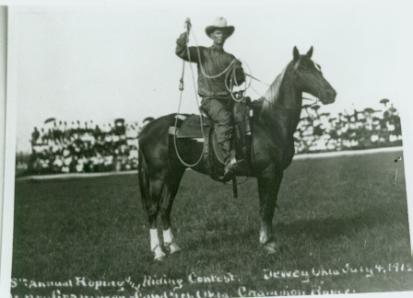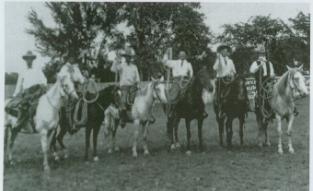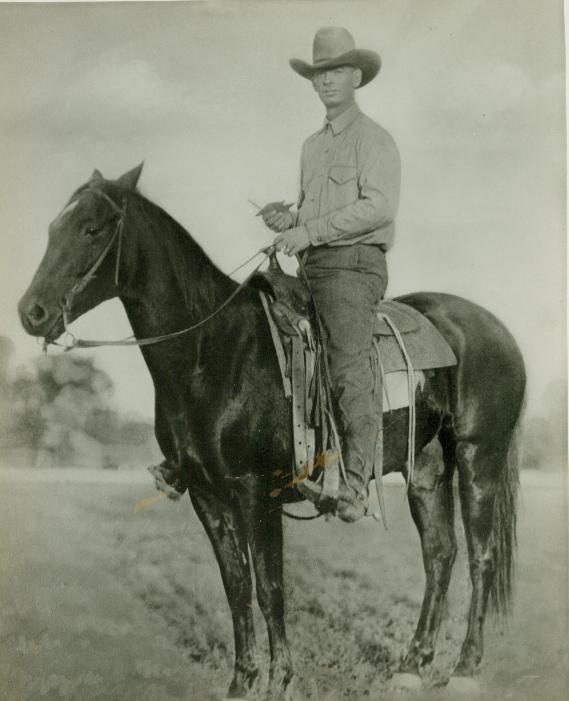"Uncle" Henry Grammer was not a direct relative of the Rowells. He was associated with the Rowell Family via C.O. "Dogtown Slim" Leuschner's marriage to Elizabeth Rowell. Although there is no direct relationship, it is appropriate here to mention Uncle Henry. As a side note, everyone in the family always refers to Henry Grammer as "Uncle Henry" so please bear with us throughout this web page as he will be referred to as "Uncle Henry".
Uncle Henry was Dogtown Slim's uncle. Dogtown's mother and Uncle Henry were brother and sister. Uncle Henry was born on July 20, 1883 in Marlin, Texas. Not much is known about his childhood, but sometime in 1901 at the age of 8 he arrived in the Osage County of Oklahoma with his family on a trainload of cattle owned by the Kuykendalls of Carizo Springs, Texas.
Sometime in the early 1900's Uncle Henry went to work for the Bloom Cattle Company. The Bloom Cattle Company had a ranch in Montana called Circle Diamond. The offshoot of the Bloom Cattle Company was running about 40,000 head of cattle. Uncle Henry was one of the cowboys at Horse Camp Coulee, one of the Circle Diamond headquarters. He was about 20 years old at the time and it was during this time that Uncle Henry developed his cowboy skills that would soar him into a rodeo legend.
After working in Montana, Uncle Henry returned to the Osage County in Oklahoma and married Mary Alexander, an Osage Indian girl. He was about 24 and Maggie was 23 years old. Though Henry's travels as a steer roper and bronc rider, they would remain completely devoted to one another until Uncle Henry's death.
Henry worked for awhile as a tick inspector for the Katy Railroad Company. However, Henry began to compete in jackpot steer ropings. One of the first he competed was in the Osage County in Pawhuska. Henry roped 3 steers in 112 seconds. This was the beginning of Henry's skyrocketing career as a steer roper, and the Osage County over the next two decades because it became the premier steer roping place in the U.S. The steer ropers would become the "elite" of the rodeo events.
Steer roping was the hardest of all the rodeo events and only a few would actually develop the skills necessary to master the event. A good steer roper needed to have a perfect sense of timing and ability to judge the distance between the horse and steer. There was also the need to calculate the speed of the horse and the running steer along with the amount of the rope to span the distance between the horse and steer. Uncle Henry had a sixth sense and intuition when it came to steer roping and quickly became an expert.
The teams were broken into six contests. One team was the Cherokee Cowboys and the other the Osage Cowboys - of which Henry was one of the competitors. The Osage Cowboys won and Uncle Henry turned in the best time of 44 seconds.
In 1908 Jake Bartles sold out his interests in Bartlesville and moved his store to a small farmland several miles north. He called this new town Dewey. In 1908 Jake decided to host a reunion with his fellow Civil War Veterans. Jake and his son prompted a riding and roping contest for July 3, 4 and 5. This event grew and grew and top rodeo hands from all over the west participated in it every year. Over the next few years the Dewey rodeo would become one of the most prestigous rodeos of its time equaling that of Pendleton, Cheyenne, Madison Square Garden and the Calgary Stampede. Uncle Henry competed in the Steer Roping and Bronc Riding events at the Dewey Rodeo for fourteen years giving the spectators a show of a life time winning both the steer roping and bronc events many times.
In 1912 Uncle Henry helped rodeo promoter put on the first Calgary Stampede in Canada.
In 1916, rodeo promoter
Guy Weadick decided to put on a "real" rodeo with real working cowboys.
People in the East were familar with Wild West Shows, but Weadick wanted them
to see how real working cowboys go about their daily "cowboy" work.
He secured the Sheepshead Bay Speedway in Brooklyn, New York and sent a call
out to all cowboys across the west to compete. The very best cowboys answered
the call and the show was a huge hit. Former President Teddy Roosevelt and
Will Rogers attended the event. Will Rogers invited the all the cowboys to
be his guest at the New Amsterdam Theatre were he was performing. On the final
day, Uncle Henry was crowned the World Champion Steer Roper.


The event that took place next, put the crowd on the each of their seats. It was announced that a jackpot roping between Henry Grammer and Ben Johnson, father of the famous actor Ben Johnson, Jr., for a purse of $1,000. However, some reports say that the actual amount was $10,000.
Bob Clark, a Fairfax banker, claims that he saw Henry take off a ring in order to cover the bet. Money was flowing heavily between the supporters of each man. Ben Johnson was about 13 years younger than Henry. Although Henry had years of experience on Ben Johnson, he was coming on strong and was at the top of his form. He would go on and win the steer roping at Cheyenne in 1922, 1923 and 1927. In 1927 at Pendleton, Oregon he would steer rope 3 steers in an average of 18 seconds.
Henry Grammer's fame as a steer roper was well-known and every rodeo promoter and producer wanted him at their rodeo. For many years Henry roped across the southwest and the midwest, and participated in most of the major rodeos of the day, including Cheyenne, Madison Square Garden, St. Louis, and Forth Worth.
From 1909 to 1910, he performed in South America with J.Ellison and the IXL Wild West Show.
In 1912, he helped Guy Weadick stage the first Calgary Stampede and in 1914 he went to London with the performers from the 101 Ranch.
Henry Grammer was truly a cowboy legend and it is well known that he helped many other cowboys get started in the rodeo business by paying their fees and letting them tag along with him to learn to steer rope and ride bucking horses. Many of the steer ropers of his time would hire some young guy to trail horses from one roping to another. This way the roper wouldn't be riding his favorite roping horse miles and miles from one rodeo to another rodeo. Henry Grammer would ride in a buggy with his wife and anyone else who wanted to go along.
Henry Grammer and his fellow cowboys were daring, wild, romantic and chivalrous, just like the lives they lived.
Henry Grammer died in 1923 at the age of forty. In 2000 he was inducted into the National Cowboy Hall of Fame in Oklahoma City, Oklahoma.
Mr. Arthur Shoemaker of Oklahoma, a cowboy, writer and historian of the American West, wrote a book about Uncle Henry. If you would like to purchase this book, you can find it on the following link on Amazon.Com.
The Road to Marble Halls - The Henry Grammer Saga

The Harry Rowell Family A Rodeo Legacy |
"Uncle" Henry Grammer
A Cowboy Legend